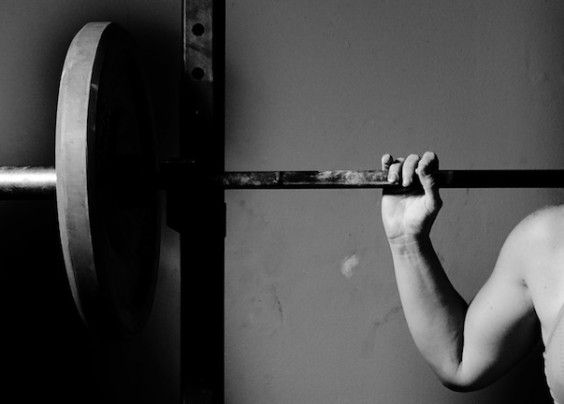Photo: Greg Westfall
To get the most out of a workout routine, we all need encouragement. But sometimes what sounds like support (“Keep going! Push harder!”) may risk promoting unhealthy, addictive relationships with exercise. Researchers estimate as much as three percent of gym-goers use fitness in ways that risk doing more harm than good to their health
One organization has dedicated itself to teaching coaches and trainers the warning signs or exercise and eating disorders. Launched in 2012, Destructively Fit is an ACE and NASM-certified three hour training course designed by eating disorder specialist Jodi Rubin. Concerned that many gym employees lacked awareness about the subject, Rubin is working to bridge the gap between the fields of fitness and mental health. Her organization aims to help fitness professionals identify when a gym-goer’s fitness routine is bordering on a problem.
We sat down with Rubin to talk about the risks of continued overexertion — osteoporosis, kidney failure, and cardiovascular damage, to name a few — and what we can all do to combat the stigma of exercise disorders.
What inspired you to create Destructively Fit?
I was already working with trainers and fitness professionals on behalf of my psychotherapy patients, advising them on the unique needs and issues in working with clients who were overcoming eating and exercise disorders. I’m also interested in fitness myself, and, like most people who go to gyms, I noticed people overdoing it at the facilities I went to. I started wondering what gyms were doing about this obvious problem. I started questioning the ethical and legal guidelines — only to find there were none pertaining to eating disorders within the fitness industry.
[After] speaking with as many people in the fitness industry as I could, it became clear that the topic of eating disorders felt like a taboo subject — people assumed they shouldn’t bring it up because they were never taught to address it.
When you join a gym, you’re asked about your health history — cardiovascular problems, past injuries, current medications, etc. But you’re rarely asked whether you’ve ever had an issue with food or exercise, even though we know the devastating health consequences of having an eating disorder. So I designed a program to train fitness professionals to understand what eating disorders are, signs and symptoms, and how to address these issues within their scope of practice.
In your program, you stress the importance of avoiding the phrase “exercise addiction.” Why?
These are true disorders, not addictions. Excessive exercise is usually part of an eating disorder — it’s an imbalance, a misuse of behavior, an unhealthy relationship with one’s body — and it needs to be treated as such. The abstinence models that work for, say, drug or alcohol addictions, don’t necessarily apply to treating eating disorders. Additionally, there’s no abstinence model for exercise disorders. Not exercising at all is just as unhealthy as exercising too much.
What are the tell-tale signs (or symptoms) that a client or gym-goer is using exercise in an unhealthy manner?
Not all of them are obvious. Most people struggling with exercise aren’t emaciated, and you can’t tell just by looking at them. More noticeable red flags include exercising multiple times a day, exercising to the point of exhaustion, preoccupation with exercise or severe distress when you can’t exercise. Another sign: exercising in spite of illness or injury — I’ve seen men and women literally running in casts. And then there’s the less tangible connection between exercise and self-esteem: It becomes increasingly hinged on the number of miles you run, or the number of calories you burn, rather than who you are as a person, outside the gym.
What do you think causes people to use exercise in an unhealthy manner?
It comes down to a collision of biological, psychological, familial, and social factors. [These] combine to create a vulnerability to developing an eating disorder and the unhealthy behaviors, like overuse of exercise, that go along with it. A big part of it is low self-esteem and the attachment of self-esteem to exercise. We all walk around the same cities, live in the same world, are faced with the same advertisements and cultural pressures. But not everyone develops an eating disorder. There needs to be an emotional vulnerability in order to use exercise or food destructively against oneself.
Do you think the fitness industry encourages unhealthy body image, exercise, and eating behaviors?
This is a tricky one, because I don’t think everyone in the fitness industry encourages unhealthy behaviors. However, there is a huge amount of focus on weight and body composition ideals that don’t take into account individual bodies — it seems to be the running assumption that everyone who works out wants to lose weight and get ripped. The marketing cues gyms and fitness campaigns use can be really motivating for some people but very destructive for others. Fitspo also strongly resembles thin-spo, which supports the idea of achieving an unrealistic and dangerous ideal of thinness.
What’s the best way for a personal trainer or fitness instructor to approach a client they suspect has a problem?
There’s really no singular, or best, way to approach someone. There’s a reason my course is three hours! Each person’s problematic use of exercise and confrontation is an incredibly sensitive issue. In general, approaching someone from a place of honesty, openness, lack of judgment, and support is a good start, but it takes more than this. Sometimes a person isn’t ready to be approached. Each case comes with its own nuances. Hence the need for a training program to help fitness industry professionals sensitively approach clients with attention to the nuances of that client’s problem.
[Note: This interview has been edited for clarity and length.]
Photo: Keith Barraclough

